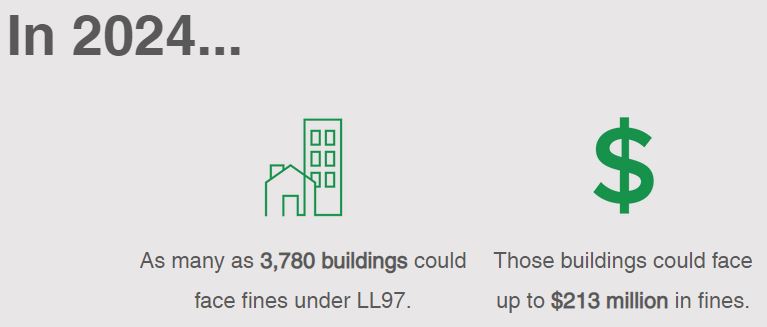Report: Fines on NYC property owners for buildings emissions could exceed $900M yearly by 2030

Image courtesy of LL97facts.com
A new study by Level Infrastructure, a leading engineering consulting firm, found that thousands of properties are on track to be out of compliance with New York City’s buildings emissions law by 2030 — even if they make significant investments to improve energy efficiency or purchase renewable energy credits. Undertaken to better understand the impact of recently finalized rules to implement Local Law 97, the compliance study was commissioned by the Real Estate Board of New York (REBNY) and underscores the significant economic disruption that will occur if property owners are not provided adequate tools to reduce buildings emissions.
The study found that as soon as next year, over 3,700 properties could be out of compliance and face over $200 million per year in penalties. By 2030, this number grows to over 13,500 properties that cumulatively could face penalties as high as $900 million each year.
While some have argued that building owners can achieve compliance with the law relatively easily, the study found that substantial investment in energy efficiency will not be enough for many buildings to achieve compliance. According to the study, by 2030, if every building reduces its energy consumption by 15%, over 11,400 buildings will still be out of compliance and owe fines of $576 million each year. Further, even if every building were to reduce its energy consumption by 30% by 2030, over 8,000 buildings will be facing penalties in excess of $300 million each year.
Building owners of all property types are positioned to face penalties, but multifamily rental and co-op and condo will be among those most impacted as they lack the resources to fully fund and coordinate compliance. Over 60% of all buildings out of compliance in 2024 are projected to be residential, climbing to nearly 66% in 2030.
In addition, the study found that recently imposed limits on the ability to utilize renewable energy credits (REC) — one of the compliance tools in Local Law 97 — will significantly constrain the ability of building owners to comply with the law. According to the study, the Department of Buildings’ recent rule curtailing REC usage to only electricity-associated emissions will require over 9,000 properties to take additional measures to reduce emissions beyond purchasing RECs. This represents nearly 70% of buildings expected to be out of compliance in 2030.
While real estate industry leaders continue to work diligently to reduce emissions from their buildings, this study should be a wake-up call that Local Law 97 is not designed to secure the emissions reductions we need. The study’s findings demonstrate that even if buildings take meaningful steps to comply and use the tools provided by the law, owners will still be unable to meet the emissions limits and will instead pay hundreds of millions of dollars in annual penalties. We hope the City will take action over the next 12 months to avoid damage to our local economy and unfair penalties to property owners in 2024.
REBNY Senior Vice President of Policy Zachary Steinberg
Local Law 97 sets limits on the greenhouse gas emissions of buildings starting in 2024 to help New York City reach the goal of a 40 percent reduction in greenhouse gas emissions from buildings by the year 2030 and 80 percent reduction in citywide emissions by calendar year 2050. The compliance study utilizes calendar year 2019 building data based on Local Law 84 and accounts for changes to building emissions limits and carbon coefficients included in the recently finalized rules issued by the Department of Buildings related to Local Law 97.
A webpage housing the report, LL97Facts, includes council district level analysis outlining expected total penalties and penalties per square foot for buildings across 51 districts in 2024, 2030, 2035 and 2040.
